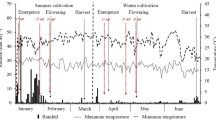Abstract
Treatments designed to influence abscisic acid (ABA) or gibberellin (GA) concentrations were applied to developing tassels of maize (Zea mays L.) plants in different environments or to anthers in culture to determine the effect on formation of embryo-like structures (ELS). Production of ELS was significantly affected in certain environments when ABA, GA3, ancymidol, or fluridone solutions were pipetted into whorls of field-grown plants approximately 3 days before tassel harvest. In 1996 anthers from 10 μM ancymidol-treated plants were most responsive, producing 35 ELS/100 anthers and 50 μM GA3-treated plants were least responsive, producing 12 ELS/100 anthers. In 1997 under hotter, drier conditions, anthers from 50 μM GA3-treated plants were most responsive, producing 20 ELS/100 anthers and those from 50 μM ABA-treated plants were least responsive, producing 2.4 ELS/100 anthers. Anthers from growth chamber plants were significantly more responsive when grown in a 16-h than a 12-h photoperiod. With the 16-h photoperiod the response was significantly greater with a 250 μM ABA whorl treatment. With the 12-h photoperiod there was no significant effect from whorl treatments. Modification of the culture medium with added ABA, GA3, ancymidol, or fluridone was generally ineffective, except in 1997 when the response was significantly higher with 1 μM ABA added to the culture medium. The results suggest that the maize anther culture response may be influenced by environmental conditions that interact with ABA and GA treatments to donor plants during tassel development.
Similar content being viewed by others
References
Beaumont VH, Rocheford TR & Widholm JM (1995) Mapping the anther culture response genes in maize (Zea mays L.). Genome 38: 968–975
Biddington NL, Sutherland RA & Robinson HT (1992) The effects of gibberellic acid, fluridone, abscisic acid, and paclobutrazol on anther culture of brussels sprouts. Plant Growth Regul. 11: 81–84
Genovesi AD & Collins GB (1982) In vitro production of haploid plants of corn via anther culture. Crop Sci. 22: 1137–1144
Guzman M & FJZ Arias (2000) Increasing anther culture efficiency in rice (Oryza sativa L.) using anthers from ratooned plants. Plant Sci. 151: 107–114
Illinois State Water Survey (1996, 1997) Champaign, IL; Local climatological data. Ill. Dept. of Nat. Resources, Champaign, IL
MacDonald MV (1992) Donor plant growth factors affecting anther culture of maize and sweetcorn (Zea mays) Ann. Bot. 70: 357–363
Maize Genetics Cooperation Newsletter (1999) Gene list and working maps. 73: 119–128
Petolino JF & Jones AM(1986) Anther culture of elite genotypes of maize. Crop Sci. 26: 1072–1074
Wan Y, Petolino JF & Widholm JM (1989) Efficient production of doubled haploid plants through colchicine treatment of antherderived maize callus. Theor. Appl. Genet. 77: 889–882
Wan Y & Widholm JM(1993) Anther culture of maize. Plant Breed. Rev. 11: 199–224
Author information
Authors and Affiliations
Corresponding author
Rights and permissions
About this article
Cite this article
Wassom, J., Mei, C., Rocheford, T. et al. Interaction of environment and ABA and GA treatments on the maize anther culture response. Plant Cell, Tissue and Organ Culture 64, 69–72 (2001). https://doi.org/10.1023/A:1010671613695
Issue Date:
DOI: https://doi.org/10.1023/A:1010671613695




